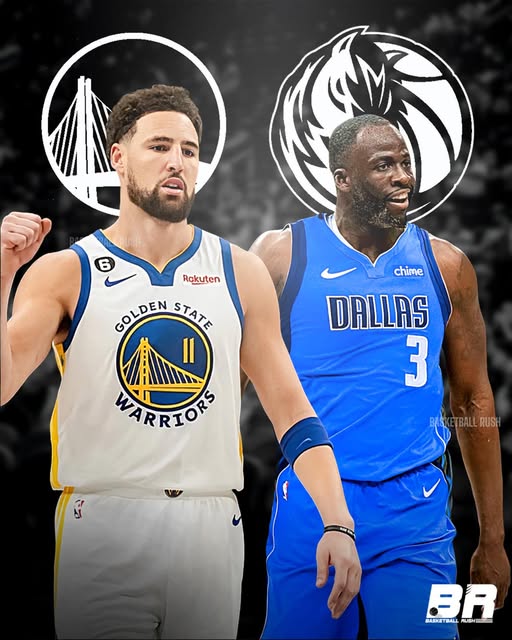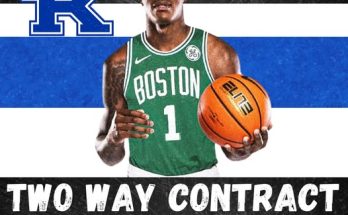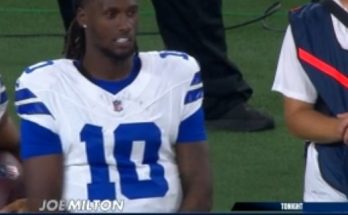In one of the most surreal trade proposals to rock the NBA world, a mock deal has surfaced that suggests a jaw-dropping reunion between Klay Thompson and the Golden State Warriors. According to this hypothetical scenario, the Warriors would re-acquire the beloved sharpshooter from his new home in exchange for veteran forward Draymond Green, young wing Moses Moody, and an eye-popping total of 23 future first-round picks. While clearly exaggerated and bordering on satirical in its scope, the sheer audacity of this trade has sparked an avalanche of discussion around loyalty, legacy, and the complicated future of the Warriors’ dynasty.
Klay Thompson, one of the most cherished and iconic players in Golden State history, parted ways with the franchise during the 2024 NBA free agency period. After 13 years of wearing a Warriors jersey, which included five NBA Finals appearances and four championships, Thompson signed with a different team in a move that stunned the Bay Area faithful. For a player whose silky shooting stroke and laid-back demeanor became synonymous with the Warriors’ identity, his departure marked the end of an era. But in the NBA, even goodbyes aren’t always permanent. The idea of a reunion — even through a mock trade — ignites a mix of nostalgia and curiosity.
The proposed trade, while fictional, taps into something very real: the emotional connection between Thompson and the fanbase, as well as the uncertainty around the Warriors’ current core. Draymond Green, the heart and soul of the Warriors’ defense, has been a polarizing figure in recent years. Once heralded for his intensity, leadership, and basketball IQ, his aggressive behavior and declining production have led some to question his long-term fit with the team’s evolving goals. Moses Moody, a promising young player with untapped potential, represents the future. Packaging him alongside Green and an absurd number of draft picks underscores the desperation — or perhaps the sheer audacity — of making an emotional play to bring back a legend.
This hypothetical deal, though tongue-in-cheek, draws attention to the Warriors’ current predicament. As Stephen Curry continues to perform at an elite level into his mid-30s, the franchise is facing the brutal reality of transition. The team missed the playoffs in 2024, and their once-feared dynasty now feels like a distant memory. Rebuilding through youth seems logical, but holding onto aging stars out of loyalty also carries risks. Trading for Thompson — who, while still capable, is not the same two-way force he once was — raises questions about whether Golden State should focus on sentiment or strategy.
The cost, even in a mock scenario, is laughably steep. Twenty-three first-round picks is clearly a hyperbolic statement, perhaps meant to emphasize the value of Thompson’s legacy rather than his current performance. No team, not even one with the deepest war chest, would ever part with that kind of draft capital. But the symbolism here is potent: how much is history worth? How far would a team go to recapture the magic of the past, even if it comes at the expense of their future?
Thompson’s departure from Golden State wasn’t bitter, but it wasn’t exactly storybook either. There were reports of frustration with his role, diminished minutes, and tension over contract negotiations. His shooting numbers had dipped, his lateral quickness wasn’t what it used to be, and defensively, he was no longer the lockdown perimeter presence he once was. Still, he remained a valuable veteran presence, a leader, and above all, a cultural pillar for the team. Watching him leave without a fitting sendoff left a void in the hearts of Warriors fans.
That’s why this mock trade, however ludicrous, resonates. It imagines a world where that unfinished chapter is completed, where Thompson returns to Chase Center, greeted by standing ovations and the same “Game 6 Klay” energy that once made him legendary. In this scenario, the Warriors get to reassemble the trio of Curry, Thompson, and potentially a retooled supporting cast for one last run — a swan song that could bring closure to one of the greatest dynasties in modern sports.
Draymond Green’s inclusion in the trade also speaks volumes. His relationship with the organization has seen its share of ups and downs. From altercations with teammates to on-court incidents resulting in suspensions, Green’s volatility is both his greatest strength and his most glaring weakness. While he’s been an essential part of the Warriors’ identity — the engine of their defense, the emotional spark plug, the vocal leader — his value is not untouchable. Moving him in a mock trade for Thompson suggests a willingness to sacrifice chemistry in one area to recapture it in another.
Moses Moody, meanwhile, represents the bridge between eras. A hardworking young guard with potential to grow into a major contributor, he’s the kind of player rebuilding teams covet. His inclusion in the trade, even as a mock detail, is a reminder that championship windows often close faster than they open. For the Warriors, hanging onto players like Moody may be more prudent than clinging to past icons — yet sentiment often clouds judgment in sports, particularly for teams steeped in legacy.
There’s also an economic and business side to consider. Thompson remains a fan favorite, and his jersey still sells. His return would boost ticket sales, merchandise revenue, and media coverage. From a branding standpoint, bringing back a franchise icon would be a marketing coup. But business decisions in the NBA must also be balanced with on-court realities. If Thompson can no longer keep up with younger, faster wings or hit three-pointers at a high clip, then his nostalgic value might not translate into wins.
What this mock trade really exposes is the emotional pull of sports. Fans don’t root just for efficiency ratings and win shares — they invest in stories, memories, and moments. Klay Thompson is part of the Warriors’ mythos. His record-breaking quarters, his clutch shots, his stoic demeanor in pressure situations — all of that is etched into franchise history. His absence leaves a void that logic and metrics cannot easily replace.
If Thompson were to return — in any form — it would symbolize more than a mere roster move. It would be a cultural reset, a moment of reconnection between the past and the present. It would offer closure to a fanbase still grappling with the slow dismantling of a once-unstoppable core. It would also present a challenge to the front office: how to navigate sentiment without sabotaging sustainability.
The idea of 23 first-round picks being traded is clearly satirical, perhaps a nod to the NBA’s growing obsession with draft assets and rebuilding through the long game. But embedded in the absurdity is a real dilemma: at what point does the future outweigh the past? And in cases where the past was this glorious — with banners, rings, and unforgettable memories — can the past ever truly be replaced?
Ultimately, the mock trade won’t happen. It was never meant to. But it does its job: it forces a conversation about what Klay Thompson means to Golden State, about where the Warriors go from here, and about the delicate balance between loyalty and evolution. The very fact that such a proposal stirs up so much emotion proves that Thompson’s legacy in the Bay is alive and well.
Whether or not Thompson ever dons a Warriors jersey again, his connection to the franchise is unbreakable. He’s part of their DNA. And while mock trades come and go — often to provoke discussion or entertain fans — some ideas, no matter how outlandish, serve as a mirror to a deeper truth. In this case, the truth is clear: the Warriors miss Klay Thompson. Their fans do too. And even if the cost to bring him back is fictional and excessive, the emotional price of his absence is very, very real.



